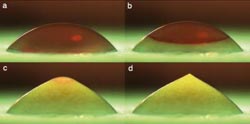Freezing water droplets form sharp ice peaks

A freezing front travels up a drop of water on a cold surface, forming a sharp point at the top.<br><br>Credit: Oscar R. Enríquez, Álvaro G. Marín, Koen G. Winkels, and Jacco H. Snoeijer, Physics of Fluids Group, University of Twente, Enschede, The Netherlands<br>
The photos are published in the American Institute of Physics' (AIP) journal Physics of Fluids. The approximately 4-millimeter diameter droplets took about 20 seconds to freeze. During the final stage of freezing, the ice drop developed a pointy tip, as can be seen in Figure 1d.
The effect, which is not observed for most other liquids, arises because water expands as it freezes. The vertical expansion of the ice, in combination with the confining effect of surface tension on the spherical cap of remaining liquid, leads to the point formation.
Once the liquid is completely frozen, the sharp tip of the drop attracts water vapor in the air, much like a sharp metal lightning rod attracts electrical charges. The water vapor collects on the tip and a tree of small ice crystals starts to grow, as seen in Figure 2. An opposite effect has been shown to preferentially extract water molecules from the sharp edge of potato wedges in the oven, the researchers note.
Article: “Freezing singularities in water drops” is published in Physics of Fluids.
Link: http://pof.aip.org/resource/1/phfle6/v24/i9/p091102_s1
Authors: Oscar R. Enríquez (1), Álvaro G. Marín (1), Koen G. Winkels (1), and Jacco H. Snoeijer (1)
(1) Physics of Fluids Group, Faculty of Science and Technology, MESA+ Institute, University of Twente, The Netherlands
Media Contact
More Information:
http://www.aip.orgAll latest news from the category: Physics and Astronomy
This area deals with the fundamental laws and building blocks of nature and how they interact, the properties and the behavior of matter, and research into space and time and their structures.
innovations-report provides in-depth reports and articles on subjects such as astrophysics, laser technologies, nuclear, quantum, particle and solid-state physics, nanotechnologies, planetary research and findings (Mars, Venus) and developments related to the Hubble Telescope.
Newest articles

Trotting robots reveal emergence of animal gait transitions
A four-legged robot trained with machine learning by EPFL researchers has learned to avoid falls by spontaneously switching between walking, trotting, and pronking – a milestone for roboticists as well…

Innovation promises to prevent power pole-top fires
Engineers in Australia have found a new way to make power-pole insulators resistant to fire and electrical sparking, promising to prevent dangerous pole-top fires and reduce blackouts. Pole-top fires pose…

Possible alternative to antibiotics produced by bacteria
Antibacterial substance from staphylococci discovered with new mechanism of action against natural competitors. Many bacteria produce substances to gain an advantage over competitors in their highly competitive natural environment. Researchers…





















